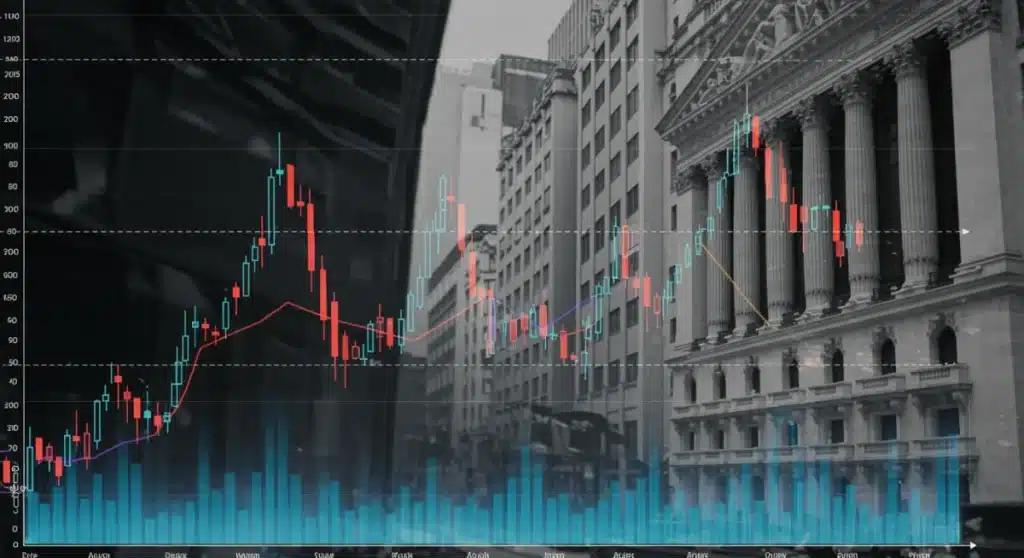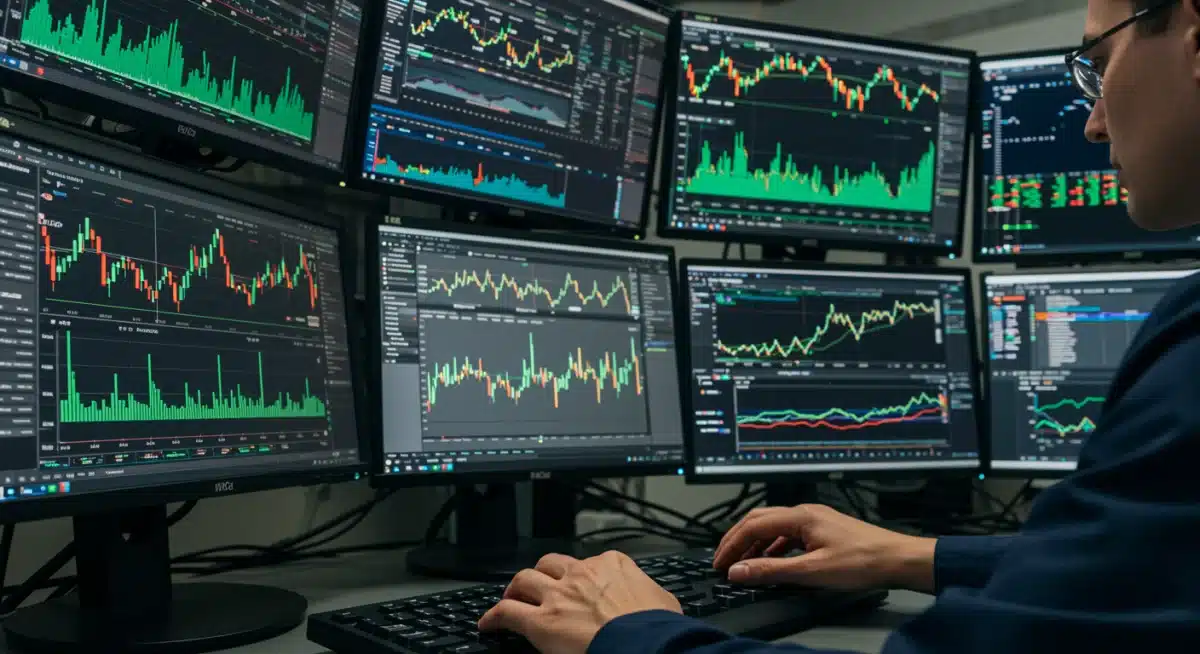US Stock Market: 10 Record Closes in Early 2024

The U.S. stock market marked an unprecedented 10 record-breaking closes within the first two months of 2024, reflecting robust corporate earnings, AI enthusiasm, and investor confidence in a resilient economy.
Did You Know that the U.S. stock market experienced 10 record-breaking closes in the first two months of 2024? This remarkable performance has captivated investors and analysts alike, signaling a powerful start to the year. This surge raises crucial questions about the underlying forces driving such rapid growth and what it means for the broader economic landscape.
Unpacking the Historic Market Rally of Early 2024
The U.S. stock market commenced 2024 with an extraordinary rally, logging 10 record-breaking closes within the first two months. This impressive streak, primarily driven by the S&P 500 and Nasdaq Composite, underscores a significant shift in investor sentiment and economic outlook. The gains have been broad, yet heavily concentrated in certain sectors, indicating specific catalysts at play.
This period of accelerated growth follows a challenging 2022 and a resilient recovery in 2023. The market’s current momentum suggests a strong underlying belief in corporate profitability and a favorable macroeconomic environment. Understanding the precise timing and magnitude of these record closes is essential for grasping the market’s current trajectory.
Key Milestones and Dates
The S&P 500, a key benchmark for the U.S. equity market, crossed several significant thresholds during this two-month period. Each record close represented a new high, pushing valuations into uncharted territory. These milestones were not isolated incidents but rather a series of sustained advances.
- January 19, 2024: S&P 500 closes at a new all-time high, surpassing its previous record from two years prior.
- February 2, 2024: Continues its upward trajectory, fueled by strong tech earnings reports.
- February 15, 2024: Marks another significant record as inflation data shows signs of cooling, boosting rate cut hopes.
- February 29, 2024: Concludes the two-month period with its tenth record close, solidifying the early 2024 bull run.
Driving Forces Behind the Record-Breaking Performance
Several interconnected factors have converged to propel the U.S. stock market to these unprecedented levels. A combination of robust corporate earnings, particularly from the technology sector, and growing optimism surrounding artificial intelligence (AI) advancements has played a pivotal role. Moreover, shifting expectations regarding interest rates and a resilient U.S. economy have provided a strong foundation for growth.
Investors are increasingly confident that the Federal Reserve can navigate a ‘soft landing,’ where inflation cools without triggering a severe recession. This sentiment has encouraged greater risk-taking and investment in equities, especially in companies poised to benefit from technological innovation and economic stability.
Technology Sector Dominance
The technology sector, often referred to as the ‘Magnificent Seven,’ has been a primary engine of this rally. Companies like Nvidia, Microsoft, and Apple have seen their stock prices soar, driven by strong earnings, promising AI initiatives, and their dominant market positions. Their influence is so significant that their performance often dictates the direction of the broader market indices.
The anticipation of AI’s transformative impact across various industries has led to substantial investment and speculative interest in companies at the forefront of this technology. This enthusiasm has translated into higher valuations and sustained buying pressure, contributing significantly to the record closes observed.
Economic Indicators and Investor Confidence
Beyond specific sector performance, a broader set of economic indicators has bolstered investor confidence. The U.S. economy has demonstrated remarkable resilience, with strong employment figures and consumer spending defying earlier predictions of a downturn. This economic robustness provides a fertile ground for corporate growth and profitability.
Furthermore, inflation data has shown a gradual, albeit sometimes bumpy, trend towards the Federal Reserve’s target. This has fueled expectations that the central bank will begin cutting interest rates later in the year, which typically provides a tailwind for equity markets by making borrowing cheaper and increasing corporate profits.
The Role of Federal Reserve Policy
The Federal Reserve’s monetary policy decisions are always a critical determinant of market performance. In early 2024, the market largely priced in multiple interest rate cuts for the year, anticipating a more accommodative stance from the Fed. While some of these expectations have since been tempered, the initial optimism provided a strong impetus for the market rally.
Analysts closely monitor the Fed’s communications for any hints regarding future rate movements. A perceived dovish tilt, or even a less hawkish stance, can significantly influence investor behavior and market valuations. The expectation of lower rates makes equities more attractive compared to fixed-income investments.
Comparing 2024’s Start to Historical Market Runs
The U.S. stock market’s performance in the first two months of 2024 is notable when viewed through a historical lens. While periods of strong market growth are not uncommon, achieving 10 record closes in such a short timeframe is a relatively rare occurrence. This rapid ascent invites comparisons to other bull markets and periods of significant economic expansion.
Understanding these historical precedents can offer insights into the sustainability of the current rally and potential future challenges. Past market cycles have shown that rapid gains can sometimes be followed by corrections, though the underlying economic conditions and technological drivers often differ.
Lessons from Past Bull Markets
- Dot-com Bubble (Late 1990s): Characterized by speculative fervor in internet companies, leading to unsustainable valuations.
- Post-2008 Financial Crisis Recovery (2009-2020): A prolonged bull market fueled by quantitative easing, low interest rates, and technological innovation.
- Post-COVID Recovery (2020-2021): Rapid bounce-back driven by unprecedented fiscal and monetary stimulus, coupled with vaccine optimism.
Each period had unique drivers, but common themes often include technological disruption, accommodative monetary policy, and strong corporate earnings. The current rally shares some of these characteristics, particularly the emphasis on technological innovation and the anticipation of favorable monetary conditions.

Potential Risks and Headwinds Ahead
Despite the bullish start to 2024, the market faces several potential risks and headwinds that could temper future growth. Geopolitical tensions, persistent inflation pressures, and the possibility of a policy misstep by central banks remain significant concerns. Investors are keenly aware that market momentum can shift rapidly in response to new information or unforeseen events.
The concentration of market gains in a few large-cap technology stocks also presents a risk. If these companies were to falter, it could have a disproportionate impact on the broader market indices. Diversification and careful risk management remain crucial in such an environment.
Key Concerns for Investors
- Inflation Resurgence: Unexpectedly high inflation could force the Federal Reserve to maintain higher interest rates for longer, potentially dampening economic activity.
- Geopolitical Instability: Escalating conflicts or new international crises could disrupt supply chains, increase commodity prices, and reduce global trade.
- Overvaluation Concerns: Some analysts suggest that certain segments of the market, particularly in tech, might be overvalued, making them vulnerable to corrections.
- Corporate Earnings Slowdown: A deceleration in corporate profit growth could undermine the rationale for current high stock valuations.
Sectoral Performance and Market Breadth
While the overall market indices have reached new highs, the performance across different sectors has not been uniform. The technology and communication services sectors have led the charge, primarily due to the enthusiasm surrounding artificial intelligence and strong earnings from key players. However, other sectors have also contributed, albeit to a lesser extent.
Market breadth, which refers to the number of individual stocks participating in a rally, is an important indicator of its sustainability. A broad-based rally, where many stocks across various sectors are advancing, is often considered healthier than one driven by just a few large companies. In early 2024, while tech dominated, there were signs of broadening participation.
Utilities and consumer staples, traditionally defensive sectors, have shown more modest gains, reflecting a market that is still favoring growth-oriented assets. This dynamic highlights the ongoing shifts in investor preferences and the perceived risk-reward balance across different industries.
Investor Sentiment and Future Outlook
Investor sentiment remains largely positive, buoyed by the strong market performance and optimistic economic projections. Surveys of individual and institutional investors indicate a prevailing belief that the rally has further room to run. However, a degree of caution is also present, with many acknowledging the potential for volatility and the need for vigilance.
Looking ahead, the market’s trajectory will likely be influenced by several key factors. The pace of inflation, the Federal Reserve’s interest rate decisions, corporate earnings reports, and geopolitical developments will all play a significant role. Analysts are closely watching for signs of sustained economic growth coupled with manageable inflation, which would provide a solid foundation for continued market strength.
The early 2024 performance has set a high bar, and maintaining this momentum will depend on a delicate balance of favorable economic conditions and robust corporate execution. Investors will need to stay informed and adapt to evolving market dynamics to navigate the opportunities and challenges that lie ahead.
| Key Point | Brief Description |
|---|---|
| Record Closes | U.S. stock market achieved 10 record-breaking closes in the first two months of 2024. |
| Key Drivers | Strong corporate earnings, AI optimism, and resilient economic indicators fueled the rally. |
| Tech Sector Impact | Technology giants significantly contributed to the market’s upward momentum. |
| Future Outlook | Continued growth depends on inflation, Fed policy, and geopolitical stability. |
Frequently Asked Questions About the 2024 Market Rally
It signifies that a major stock index, like the S&P 500, closed trading at a higher price than it ever has before. This indicates strong investor confidence and positive market momentum, driven by various economic and corporate factors.
The S&P 500 and the Nasdaq Composite were the primary indices reaching these record closes. The Dow Jones Industrial Average also saw significant gains, reflecting broad market strength.
Optimism surrounding AI advancements, particularly in companies leading AI development and integration, spurred significant investment. Strong earnings from tech giants involved in AI further boosted their stock prices and, consequently, the broader market.
Market sustainability depends on continued strong corporate earnings, controlled inflation, and stable geopolitical conditions. While the start was robust, potential headwinds like interest rate uncertainty and global events could introduce volatility.
Initial market optimism was fueled by expectations of multiple interest rate cuts by the Federal Reserve in 2024. Lower rates typically make equities more attractive and reduce borrowing costs for companies, boosting profitability and investor sentiment.
What This Means
The U.S. stock market’s unprecedented 10 record-breaking closes in early 2024 underscore a powerful narrative of economic resilience and technological optimism. This significant surge indicates that investors are largely shrugging off lingering inflation concerns and geopolitical uncertainties, instead focusing on robust corporate earnings and the transformative potential of AI. For the average investor, this period highlights the importance of staying informed and understanding the underlying drivers of market movements. The current environment suggests a market that is both dynamic and sensitive to key economic data and corporate performance, setting the stage for continued close observation.